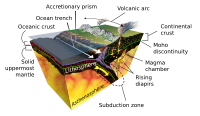
Photo from wikipedia
Volcanic arcs above subduction zones are thought to be the principal locations where juvenile magmatic crust forms and is refined to become continental crust with an andesitic composition. During this… Click to show full abstract
Volcanic arcs above subduction zones are thought to be the principal locations where juvenile magmatic crust forms and is refined to become continental crust with an andesitic composition. During this refinement mechanism, the formation of dense garnet pyroxenites (arclogites), represented by high-pressure cumulates and restites after partial melting, leads to the delamination of the lower arc crust. The Mercaderes-Río Mayo area in southern Colombia is the only known locality in an active volcanic arc where arclogitic xenoliths have been recovered. These xenoliths are entrained in the Granatifera Tuff, a late Cenozoic volcanic vent, and they mainly consist of garnet, clinopyroxene, amphibole, plagioclase, rarely scapolite, and accessory mineral inclusions of rutile, apatite, zircons, and quartz. Moreover, the arclogites are also characterized by the presence of melt inclusions (MI), which are mainly found within garnet, but can be also observed in amphibole, plagioclase, clinopyroxene, and scapolite. The glasses measured for the MI in garnet and scapolite typically have SiO2-contents >57 wt.%, ranging from andesite to rhyolite in composition. Petrographic and geochemical investigations allowed to discriminate between cumulitic and restitic arclogites, with the latter showing the concomitant presence of primary MI and quartz inclusions within the peritectic garnets. Therefore, our study provides for the first time a strong evidence, at the microscale, for the anatectic origin of some arclogitic xenoliths. Pressure and temperature conditions for the studied arclogites were estimated by intracrystalline geothermometry, elastic geothermobarometry, phase equilibria modelling and classical Fe–Mg exchange between garnet and clinopyroxene. Results mainly fall within the range 960-1150°C and 1.6-1.9 GPa for most samples. We suggest that the investigated arclogites derive from the root of the active Colombian volcanic arc, where differentiation processes from mantle-derived melts and lower crust anatexis occur in close association.
Journal Title: Journal of Petrology
Year Published: 2023
Link to full text (if available)
Share on Social Media: Sign Up to like & get
recommendations!